
10 minute read
Essential lithium
Lithium is the lightest of all metals, has the greatest electrochemical potential and provides the largest specific energy per weight.
It was not until the early 1970s that the first non-rechargeable lithium batteries became commercially available. Attempts to develop rechargeable lithium batteries followed in the 1980s but the endeavour failed because of instabilities in the metallic lithium used as anode material.
Rechargeable batteries with lithium metal on the anode (negative electrodes) can provide extraordinarily high energy densities, however, cycling produces unwanted dendrites on the anode that can penetrate the separator and cause an electrical short. The cell temperature then rises quickly and approaches the melting point of lithium, causing thermal runaway, also known as “venting with flame”.
The inherent instability of lithium metal, especially during charging, shifted research to a non-metallic solution using lithium ions. Although lower in specific energy than lithium-metal, Liion is safe, provided cell manufacturers and battery packers follow safety measures in keeping voltage and currents to secure levels.
In 1991, Sony commercialized the first Li-ion battery, and today this chemistry has become the most promising and fastest growing on the market. Meanwhile, research continues to
*
Also or develop a safe metallic lithium battery in the hope to make it safe.
In 1994, it cost more than $10 to manufacture Li-ion in the 18650 cylindrical cell delivering a capacity of 1,100mAh. In 2001, the price dropped to $2 and the capacity rose to 1,900mAh. Today, high energy-dense 18650 cells deliver over 3,000mAh and the costs have dropped further.
Cost reductions, the increase in specific energy and the absence of toxic materials have paved the road to make Li-ion the universally acceptable battery for portable applications, first in the consumer industry and now increasingly also in heavy industry, including electric powertrains for vehicles.
In 2009, roughly 38% of all batteries by revenue were Li ion. Li-ion is a lowmaintenance battery, an advantage many other chemistries cannot claim. The battery has no memory and does not need exercising to keep in shape.
Self-discharge is less than half compared to nickel-based systems. This makes Li ion well suited for fuel gauge applications. The nominal cell voltage of 3.6V can power cell phones and digital cameras directly, offering simplifications and cost reductions over multi-cell designs. The drawback has been the high price, but this is levelling out, especially in the consumer market.
Types of Lithium-ion batteries
Li ion batteries come in many varieties but all have one thing in common — the catchword “lithium-ion.” Although strikingly similar at first glance, these batteries vary in performance, and it’s mostly the cathode material that gives then their unique personality.
Table 1 gives six of the most common lithium-ion batteries with examples of typical uses. Their full chemical names and colloquial short names are also given.
To learn more about the unique characters and limitations of the six lithium-ion families, it is helpful to examine the batteries in the form of spider charts. We begin with Li-cobalt, the most common variety used in cellular phones and laptops. We then move to Li-manganese and Li-phosphate, automotive propulsion systems, as well as stationary and grid storage applications, also known as load levelling. batteries deployed in power tools, and finally address the newer players such as NME, NCA and Li-titanate.
Lithium cobalt oxide (LiCoO2)
Li-cobalt is the most popular consumer battery. Its high specific energy provides satisfactory runtime for cell phones, laptops and digital cameras. The battery consists of a cobalt oxide cathode and a graphite carbon anode. The cathode has a layered structure and during discharge lithium ions move from the anode to the cathode. The flow reverses on charge. The drawback of Li-cobalt is a relatively short life span and limited load capabilities (specific power).
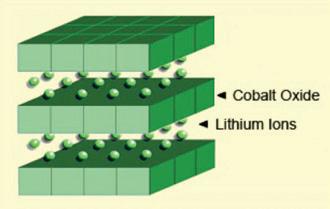
Figure 2 illustrates the structure.
1920mA. The mandatory battery protection circuit limits the charge and discharge rate to a safe level of about 1C.
Figure 3 summarizes the performance of Li-cobalt in terms of specific energy, or capacity; specific power, or the ability to deliver high current; safety; performance at hot and cold temperatures; life span reflecting cycle life and longevity; and cost. The hexagonal spider web provides a quick and easy performance analysis of the battery characteristics.
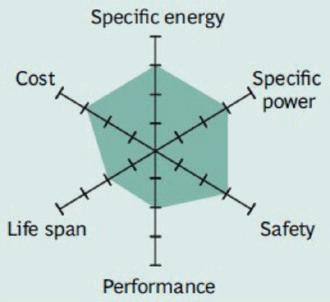
Lithium manganese oxide (LiMn2O4)
Lithium insertion in manganese spinels was first published in the Materials Research Bulletin in 1983. In 1996, Moli Energy commercialized a Li-ion cell with lithium manganese oxide as a cathode material.
The architecture forms a three-dimensional spinel structure that improves ion flow on the electrode, which results in lower internal resistance and improves current handling. A further advantage of spinel is high thermal stability and enhanced safety, but the cycle and calendar life is limited.
lattice, appears after initial formation.
The cathode has a layered structure. During discharge the lithium ions move from the anode to the cathode; on charge the flow is from cathode to anode.
Li-cobalt cannot be charged and discharged at a current higher than its rating. This means that an 18650 cell with 2,400mAh can only be charged and discharged at 2,400mA. Forcing a fast charge or applying a load higher than 2,400mA causes overheating and undue stress.
For optimal fast charge, the manufacturer recommends a C-rate of 0.8C or
Low internal cell resistance is key to fast charging and high-current discharging. In an 18650 package, Li-manganese can be discharged at currents of 20A–30A with moderate heat buildup. It is also possible to apply one-second load pulses of up to 50A. A continuous high load at this current would cause heat buildup and the cell temperature cannot exceed 80°C (176°F). Li-manganese is used for power tools, medical instruments, as well as hybrid and electric vehicles.
Figure 4 shows the crystalline formation of the cathode in a threedimensional framework. This spinel structure, which is usually composed of diamond shapes connected into a
Li-manganese has a capacity that is roughly one-third lower compared to Li-cobalt but the battery still offers about 50% more energy than nickel-based chemistries. Design flexibility allows engineers to maximize the battery for either optimal longevity (life span), maximum load current (specific power) or high capacity (specific energy).
For example, the long-life version in the 18650 cell has a moderate capacity of 1,100mAh; the high-capacity version is 1,500mAh but has a reduced service life. Laptop manufacturers would likely choose the high-capacity version for maximum runtime; whereas the maker of cars with the electric powertrain would take the long-life version with high specific power and sacrifice on runtime.
Figure 5 shows the spider web of a typical Li-manganese battery. In this chart, all characteristics shown appear marginal, however, newer designs have improved in terms of specific power, safety and life span.
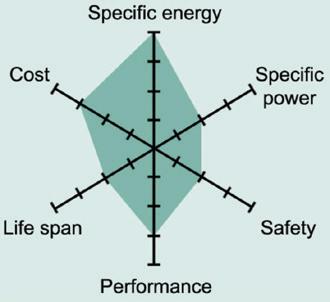
Lithium iron phosphate (LiFePO4)
In 1996, the University of Texas (and other contributors) discovered phosphate as cathode material for rechargeable lithium batteries. Liphosphate offers good electrochemical performance with low resistance. This is made possible with nano-scale phosphate cathode material.
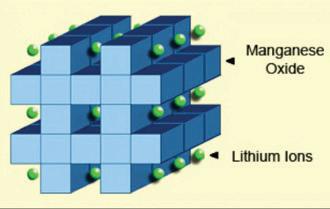
The cathode crystalline formation of lithium manganese oxide has a three-dimensional framework structure that appears after initial formation. Spinel provides low resistance but has a more moderate specific energy than cobalt.
The key benefits are enhanced safety, good thermal stability, tolerant to abuse, high current rating and long cycle life. Storing a fully charged battery has minimal impact on the life span. As trade-off, the lower voltage of 3.3V/cell reduces the specific energy to slightly less than Li-manganese. In addition, cold temperature reduces performance, and elevated storage temperature shortens the service life (better than lead acid, NiCd or NiMH). Li-phosphate has a higher self-discharge than other Li-ion batteries, which can cause balancing issues with aging.
Figure 6 summarizes the attributes of Li-phosphate.
Lithium nickel manganese cobalt oxide (LiNiMnCoO2)
Leading battery manufacturers focus on a cathode combination of nickelmanganese-cobalt (NMC). Similar to Li-manganese, these systems can also be tailored to high specific energy or high specific power, but not both.
For example, NMC in an 18650 cell for consumer use can be tweaked to 2,250mAh, but the specific power is moderate. NMC in the same cell optimized for high specific power has a capacity of only 1,500mAh. A silicon-based anode will be able to go to 4,000mAh; however, the specific power and the cycle life may be compromised.
The secret of NMC lies in combining nickel and manganese. An analogy of this is table salt in which the main ingredients of sodium and chloride are toxic on their own but mixing them serves as seasoning salt and food preserver.
Nickel is known for its high specific energy but low stability; manganese has the benefit of forming a spinel structure to achieve very low internal resistance but offers a low specific energy. Combining the metals brings out the best in each.
NMC is the battery of choice for power tools and powertrains for vehicles.
The cathode combination of onethird nickel, one-third manganese and one-third cobalt offers a unique blend that also lowers raw material cost due to reduced cobalt content. Striking the right balance is important and manufacturers keep their recipes a well guarded secret.
Figure 7 demonstrates the characteristics of the NMC.
Lithium nickel cobalt aluminium oxide (LiNiCoAlO2)
The lithium nickel cobalt aluminium oxide battery, or NCA, is less commonly used in the consumer market, however high specific energy and specific power, as well as a long life span, get the attention of the automotive industry. Less flattering are safety and cost.
Figure 8 demonstrates the strong points against areas for further development.
Lithium have been known since the 1980s. Lititanate replaces the graphite in the anode of a typical lithium-ion battery and the material forms into a spinel structure. Li-titanate has a nominal cell voltage of 2.40V, can be fast-charged and delivers a high discharge current of 10C, or 10 times the rated capacity. The cycle count is said to be higher than that of a regular Li-ion; the battery is safe, has excellent low-temperature discharge characteristics and obtains a capacity of 80% at -30°C (-22°F). At 65Wh/kg, the specific energy is low. Li-titanate charges to 2.80V/ cell, and the end of discharge is 1.80V/ cell.
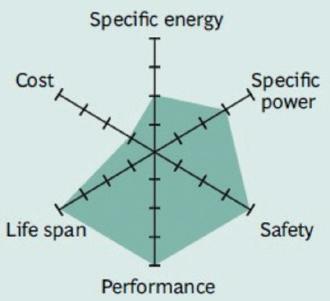
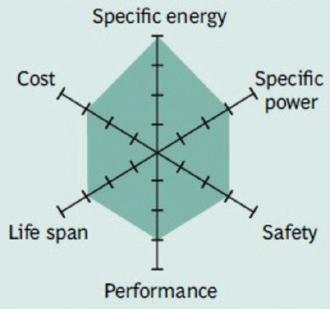
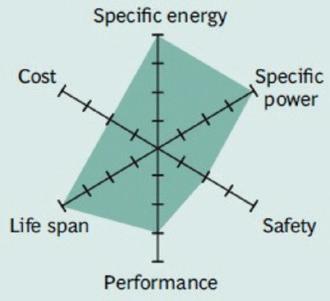
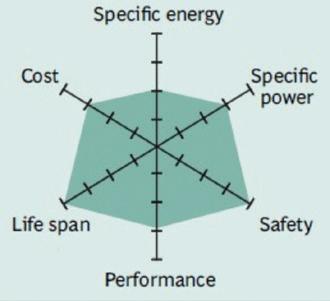
Cross-chemistry comparisons
Figure 10 compares the specific energy of lead, nickel- and lithiumbased systems. While Li-cobalt is the clear winner by being able to store more capacity than other systems, this only applies to specific energy. In terms of load characteristics and thermal stability, Li-manganese and Li-phosphate are superior.
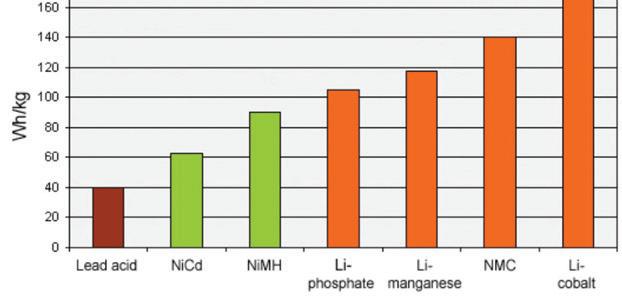
As we move towards electric powertrains, safety and cycle life will become more important than capacity.
Never was the competition to find an ideal battery more intense than
Similar to the lead- and nickel-based architecture, lithium-ion uses a cathode (positive electrode), an anode (negative electrode) and electrolyte as conductor. The cathode is a metal oxide and the anode consists of porous carbon. During discharge, the ions flow from the anode to the cathode through the electrolyte and separator; charge reverses the direction and the ions flow from the cathode to the anode.
Figure 11 illustrates the process.
When the cell charges and discharges, ions shuttle between cathode (positive electrode) and anode (negative electrode). On discharge, the anode undergoes oxidation, or loss of electrons, and the cathode sees a reduction, or a gain of electrons. Charge reverses the movement.
All materials in a battery possess a theoretical specific energy, and the key to high capacity and superior power delivery lies primarily in the cathode. For the last 10 years or so, the cathode has characterized the Liion battery.
Sony’s original lithium-ion battery used coke as the anode (coal product), and since 1997 most Li ion batteries use graphite to attain a flatter discharge curve. Developments also occur on the anode and several additives are being tried, including siliconbased alloys. Silicon achieves a 20% to 30% increase in specific energy at the cost of lower load currents and reduced cycle life.
Nano-structured lithium-titanate as anode additive shows a promising cycle life, good load capabilities, excellent low-temperature performance and superior safety, but the specific energy is low.
Mixing cathode and anode material allows manufacturers to strengthen its intrinsic qualities; however, enhancing one attribute may compromise another. Battery makers can, for example, optimize the specific energy (capacity) to achieve extended runtime, increase the specific power for improved current loading, extend service life for better longevity, and enhance safety to endure environmental stresses.
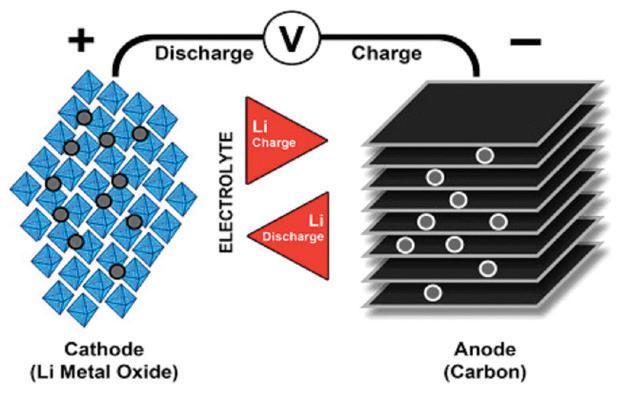
But there are drawbacks. A higher capacity reduces the current loading; optimizing current loading lowers the specific energy; and ruggedizing a cell for long life and improved safety in- creases battery size and adds to cost due to a thicker separator. The separator is said to be the most expensive part of a battery. it is today. Manufacturers see huge potential for automotive propulsion systems, as well as stationary and grid storage applications, also known as load leveling. At time of writing, the battery industry speculates that the Li-manganese or NMC might be the winners for the electric powertrain.
Table 2 (next page) summarizes the characteristics of Li-ion with different cathode materials. The table limits the chemistries to the four most commonly used lithium-ion systems and applies the short form to describe them. NMC stands for nickel-manganese-cobalt, a chemistry that is relatively new and can be tailored for high capacity or high current loading.
Lithium-ion-polymer is not mentioned as this is not a unique chemistry and only differs in construction. Li-polymer can be made in various chemistries and the most widely used format is Li-cobalt.
The long-term suitability of batteries for automotive use is still unknown.
A clear assessment of the cycle life, performance and long-term operat-

Table 2: Characteristics of the four most commonly used lithium-ion batteries ing cost will only be known after having gone through a few generations of batteries for vehicles with electric powertrains, and more is known about customer’s behavior and climate conditions under which the batteries are exposed.
Specific energy refers to capacity (energy storage); specific power denotes load capability.
Average. Requires protection circuit and cell balancing of multi cell pack. Requirements for small formats with 1 or 2 cells can be relaxed
Very high specific energy, limited power; cell phones, laptops
Very high specific energy, limited power; cell phones, laptops
High power, good to high specific energy; power tools, medical, EVs
Very
1. NMC, NCM, CMN, CNM, MNC and MCN are basically the same. The stoichiometry is usually Li[Ni(1/3)Co(1/3)Mn(1/3)]O2. The order of Ni, Mn and Co does not matter much.
2 Application and environment govern cycle life; the numbers do not always apply correctly.
3. A fully charged battery raises the thermal runaway temperature, a partial charge lowers it.










